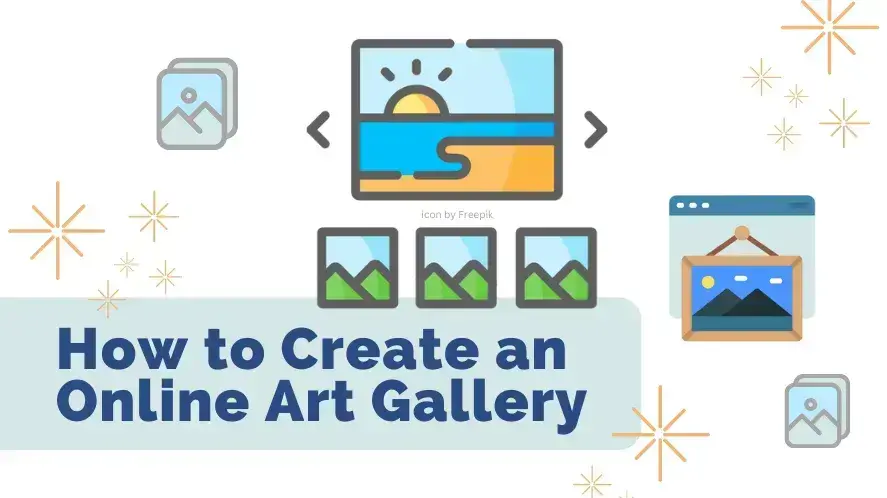The digital age has revolutionized the art world, making it accessible to a global audience. Creating an online art gallery offers a unique opportunity to showcase and sell art to collectors worldwide. This article will guide you through the essential steps of building a successful online art gallery, from conceptualization to launch and beyond.
We will delve into key aspects such as platform selection, artist curation, marketing strategies, and leveraging web applications to enhance the user experience. Additionally, we will explore successful case studies of online art galleries to provide valuable insights and inspiration.
Why Creating an Online Art Gallery
Creating an online art gallery offers a multitude of advantages for both artists and art enthusiasts. Here's a breakdown of the key reasons:
For Artists
Creating an online art gallery offers a multitude of advantages for both artists and art enthusiasts. It provides a platform for artists to reach a global audience and showcase their work without the constraints of a physical space.
Global Reach: Access a worldwide audience, transcending geographical limitations.
Lower Costs: Significantly reduced overhead compared to physical galleries (no rent, utilities, staff).
Direct Connection: Build direct relationships with collectors without intermediaries.
Data-Driven Insights: Gain valuable data on audience preferences and behavior.
Showcase Diverse Online Portfolio: Display a larger range of artwork than physical space allows.
For Collectors
For collectors, online art galleries offer unparalleled convenience and accessibility. With a vast array of artworks at their fingertips, collectors can explore diverse styles and discover new artists without leaving their homes.
Convenience: Explore art from anywhere, at any time.
Vast Selection: Access a wider variety of art styles, mediums, and price points.
Research Accessibility: Easily learn about artists and their work.
Global Discovery: Discover art from different cultures and regions.
Affordability: Potentially find art within a broader price range.
For the Art World
Online galleries democratize access to art, making it available to a wider audience. This increased exposure can stimulate interest in art and encourage new collectors to enter the market.
Democratization of Art: Makes art accessible to a wider audience.
Innovation: Fosters experimentation with digital art forms and interactive experiences.
Environmental Benefits: Reduces carbon footprint compared to traditional galleries.
Economic Growth: Contributes to the digital economy and supports artists.
The Essential Features of an Online Art Gallery
Online art gallery's platform should provide a seamless user experience for both art enthusiasts and collectors. Here's an overview of essential features and characteristics to consider when choosing a platform or building an online art gallery.
Accessibility and Global Reach
An online art gallery transcends geographical boundaries, allowing artists to connect with a global audience. Collectors can explore diverse art collections from anywhere in the world, breaking down barriers to art appreciation.
24/7 availability: Art can be viewed and purchased at any time, from anywhere in the world.
Wider audience: Online galleries can reach a global audience, expanding the potential customer base.
Geographic independence: Artists and collectors are not limited by physical location.
Digital Showcase
High-quality images, detailed descriptions, and often interactive elements provide a comprehensive showcase for artworks. This digital platform enables viewers to immerse themselves in the art, exploring pieces in detail and from various angles.
High-quality imagery: Detailed images and often videos are used to showcase artwork effectively.
Interactive features: Tools like zoom, rotate, and virtual reality can enhance the viewing experience.
Detailed information: Comprehensive descriptions, artist biographies, and artwork specifications are provided.
Well-structured grid layout: It is essential for creating a visually appealing and user-friendly online art gallery
E-commerce Integration
A seamless purchasing experience is crucial. Secure payment gateways, inventory management, and efficient shipping options are essential for facilitating art sales online.
Secure online transactions: Safe and convenient payment options are essential.
Inventory management: Efficiently tracking artwork availability and sales.
Shipping and logistics: Handling artwork packaging, shipping, and delivery.
Curated Experience
An online art gallery should offer a curated selection of artworks, creating a cohesive and engaging experience for visitors. Curators play a vital role in selecting pieces that complement each other and resonate with a specific audience.
Artist selection: Careful curation of artists and artworks to maintain gallery's identity.
Thematic exhibitions: Online galleries can create virtual exhibitions around specific themes or artists.
Personalized recommendations:Using algorithms or expert curation to suggest art based on user preferences.
Community Building
Engaging with collectors, artists, and other stakeholders through social media, forums, or events strengthens relationships and builds loyalty.
Social media integration: Engaging with collectors and artists through social platforms.
Online communities: Fostering a sense of community among art enthusiasts.
Artist representation: Building relationships with artists and promoting their work.
Data Analytics
Data analytics provide valuable insights for refining marketing strategies, improving user experience, and making informed business decisions.
Customer insights: Tracking user behavior to understand preferences and trends.
Performance metrics: Measuring website traffic, sales, and engagement.
Optimization: Using data to improve the gallery's offerings and email marketing strategies.
Innovation and Technology
Staying at the forefront of technological advancements is key to remaining competitive. Emerging technologies: Incorporating virtual and augmented reality, AI, and blockchain.
Interactive experiences: Creating immersive online art experiences.
Digital art formats: Supporting new art forms like NFTs and digital installations.
Platforms to Create an Online Art Gallery
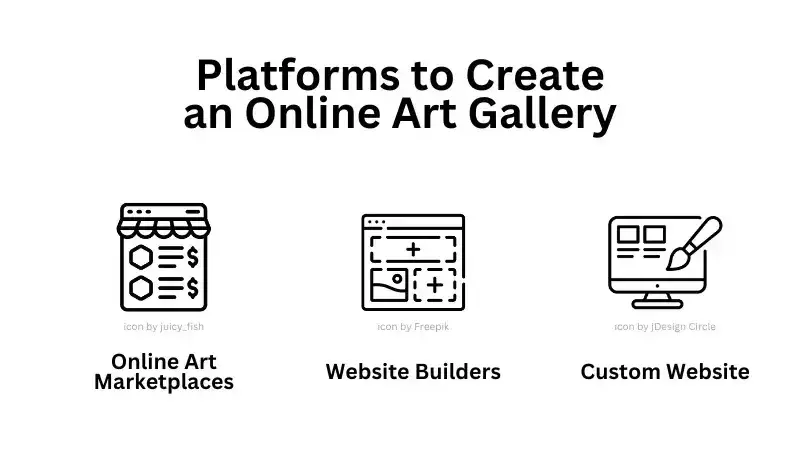
The platform you choose for your online art gallery will significantly impact its functionality, scalability, and overall user experience. Here's a brief overview of the three main options:
Online Art Marketplaces
These platforms offer a ready-made audience and infrastructure for selling art, but they often take a commission on each sale.
Saatchi Art
A popular platform for emerging artists, Saatchi Art provides a global reach, a curated selection of artwork, and a strong community of art enthusiasts. With its user-friendly interface and emphasis on visual appeal, Saatchi Art makes it easy for artists to showcase their work and connect with potential buyers. The platform also offers features like artist profiles, art collections, and promotional tools to help artists build their brand and reach a wider audience.
Artfinder
Artfinder is a thriving online marketplace that connects art buyers with independent artists from around the world. With a focus on diversity and inclusivity, the platform showcases a wide range of art styles, mediums, and price points. Artfinder offers a user-friendly interface, making it easy for artists to upload their work, manage their inventory, and engage with potential buyers. Additionally, the platform provides marketing tools and resources to help artists grow their businesses and reach a broader audience.
Etsy
While primarily known for handmade and vintage items, Etsy has a growing community of artists selling their work, including prints, original paintings, and sculptures. The platform's large user base and established reputation for unique and affordable products make it a viable option for artists looking to reach a wide audience. However, it's important to consider Etsy's focus on handmade items and its potential impact on the perception of your artwork.
Website Builders
These website builder platforms offer user-friendly interfaces and pre-designed templates to help you create a professional-looking online art gallery without requiring coding knowledge.
Wix
Known for its flexibility and customization options, Wix offers a wide range of templates specifically designed for art galleries. It includes e-commerce features, allowing you to sell artwork directly from your website.
Squarespace
Renowned for its sleek and modern designs, Squarespace provides a clean aesthetic for showcasing art. It offers strong e-commerce capabilities and integration with various payment gateways.
Shopify
Primarily an e-commerce platform, Shopify can be effectively used for online art galleries. It offers robust features for selling artwork, inventory management, and order fulfillment.
Custom Website
A custom website offers unparalleled flexibility in designing an online art gallery tailored to your specific vision. With complete control over layout, aesthetics, and functionality, you can create a unique digital space that perfectly showcases your art collection. This level of customization allows you to implement a well-structured grid layout that optimally displays your artwork, ensuring a visually appealing and user-friendly experience.
However, building and maintaining a custom website requires technical expertise, time, and ongoing resources. A Content Management System (CMS) can provide a robust foundation for building a custom online art gallery. These platforms offer flexibility, scalability, and a range of features to cater to the specific needs of an art gallery.
WordPress
Known for its flexibility and extensive plugin ecosystem, WordPress is a popular choice for creating custom websites. It offers a wide range of themes and plugins specifically designed for art galleries, allowing you to create a visually appealing and functional online space.
Joomla
Another open-source CMS, Joomla provides a strong foundation for building complex websites. It offers a variety of extensions and templates that can be customized to suit your gallery's needs.
Frequently Used Grid Layouts for Online Art Galleries
By considering the right grid layouts and incorporating best practices, you can create an online art gallery that is both visually stunning and user-friendly. Here are some common grid layouts used in the art world:
1. Equal-Sized Grid
Description: This is the most straightforward layout, featuring evenly sized squares or rectangles.
Advantages: Simplicity, easy navigation, and good for showcasing a variety of artwork styles.
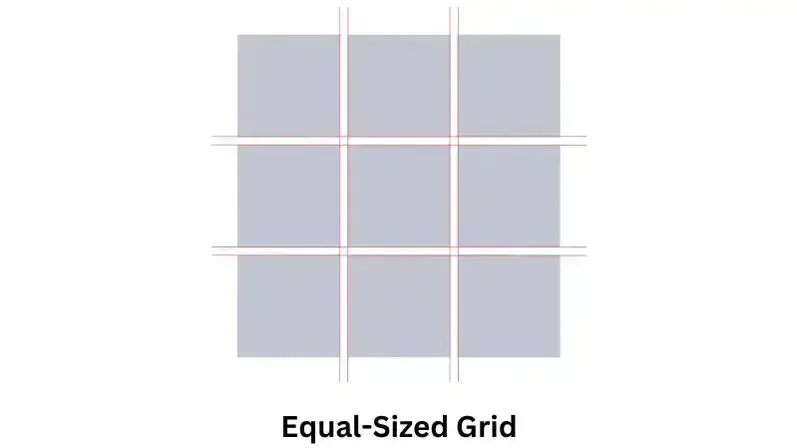
2. Masonry Grid
Description: This layout features items of varying heights, creating a visually interesting and dynamic look.
Advantages: Perfect for showcasing artwork with different aspect ratios, creating a more organic feel.
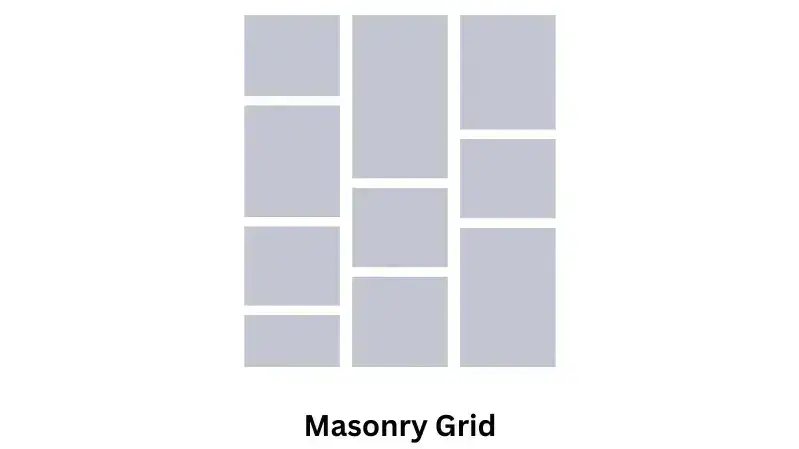
3. Pinterest-Style Grid
Description: Inspired by the popular image-sharing platform, this layout emphasizes vertical images.
Advantages: Great for showcasing detailed artwork, such as paintings and photography.
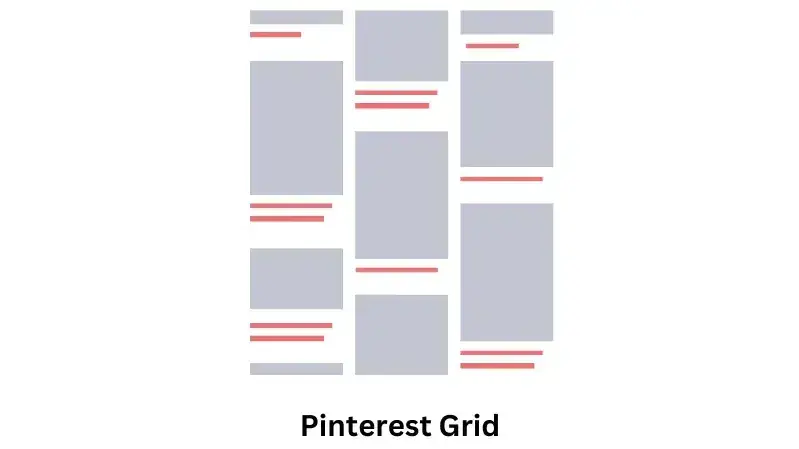
Additional Tips for Optimizing Online Art Gallery Layout
Consider these essential design and technical optimizations, to enhance the visual appeal, user experience, and overall effectiveness of your online art gallery,
- Whitespace
Employ whitespace strategically to enhance visual hierarchy and create a sense of balance. By providing ample breathing room around elements, you improve readability and allow the artwork to take center stage.
- Responsive design
Ensure your gallery adapts seamlessly to various screen sizes, from desktops to smartphones. A responsive layout guarantees a consistent and enjoyable user experience across different devices, maximizing accessibility for your audience.
- Image quality
Invest in high-resolution images to showcase the intricate details and vibrancy of your artwork. High-quality visuals leave a lasting impression and build trust with potential buyers.
- Call-to-action
Incorporate clear and compelling calls-to-action that guide visitors towards desired actions, such as purchasing artwork or subscribing to a newsletter. Strategically placed and visually distinct CTAs increase engagement and conversions.
- Loading speed
Optimize image sizes and compress files to minimize loading times. A fast-loading website improves user experience and search engine rankings, encouraging visitors to explore your gallery thoroughly.
Conclusion
By carefully considering the layout, incorporating high-quality images, and optimizing for different screen sizes, you can provide an exceptional browsing experience for your visitors. Additionally, incorporating clear calls-to-action and ensuring fast loading times will encourage engagement and conversions.
Remember, the success of your online art gallery depends on a harmonious blend of design, technology, and content. By staying up-to-date with the latest trends and user preferences, you can create a dynamic and thriving platform that attracts and retains art enthusiasts.
Frequently Asked Questions
Why is an online store better?
The main benefit of online retailing is that it’s more convenient for the customer. Customers usually opt out of buying stuff over the internet instead of going to the store due to the busy lives they live.
Who should have an online portfolio?
Online portfolios are a must for artists, graphic designers, architects, videographers, and photographers.
Do artists still need a website?
Yes. With people online more than ever, and online searches at an all-time high, having an artist website is crucial. Artists can use their website as a professional hub to showcase their work, connect with audiences, and sell their art directly.
What types of art can DALL·E generate?
DALL·E can produce AI art ranging from digital art and oil painting to impressionist painting, offering surprising and delightful results.

Audee Mirza is a graphic designer and WordPress developer at audeemirza.com who resides in Surabaya, Indonesia. She's also the author of Graphic Identity Blog, a professional logo designer, and often creates vector illustrations for clients and marketplaces. She enjoys good typography design and all kinds of animation.
View all posts by Audee Mirza















